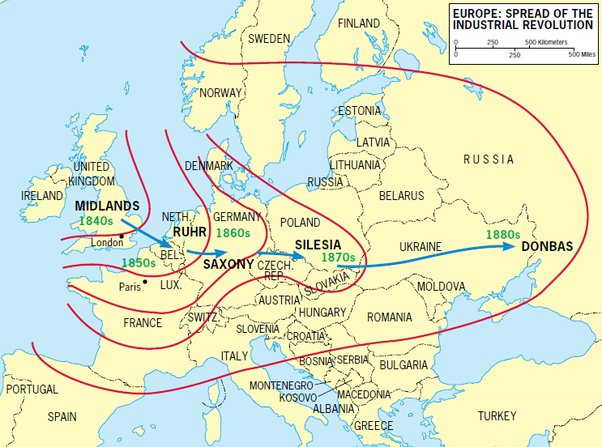17-05-2024 Mains Question Answer
Q. Compare the industrial revolution in England with that of continental Europe.
Following the pioneering Industrial Revolution in Britain, many other nations embarked on their own industrial revolutions, with continental Europe witnessing notable transformations in the 19th century. While each region experienced industrialization differently due to varying resources, political landscapes, and social and economic conditions, several similarities emerged.

- Industrial Revolution in England:
- In Britain, industrialization commenced first, spreading to mainland Europe through a process of deliberate imitation. The British experience was characterised by two distinct stages of economic growth between 1700 and 1870. Initially, technological innovations revolutionised certain industries, albeit with modest changes in national income and workforce structure.
- However, a new phase of growth emerged in the early 19th century, marked by increased coal usage, leading to significant population growth, urbanisation, and economic restructuring.
- Industrial Revolution in continental Europe:
- Many European countries lagged in adopting new forms of powered production due to high fuel costs and low wages. For instance, Belgium and Italy were slow to mechanise due to cheaper labour alternatives. The entry costs for early industrializers like Britain were lower compared to later industrializers, who faced competition from nations with more advanced industries.
- Britain, Belgium, and Germany shared similar industrialization trajectories, driven by coal, steam engines, and heavy industry.
- However, France’s experience differed due to limited coal reserves and population stagnation, leading to slower industrial development. Political turmoil and a lack of coal further delayed industrialization, although the central government played a more active role compared to Britain.
- In Germany, the central government played a significant role in fostering industrialization to catch up with Britain. Rich iron and coal resources facilitated the development of heavy industry, while strong banking sectors and cartels coordinated industrial efforts. Germany also excelled in the chemical industry and prioritised technical education, distinguishing its industrialization from Britain’s.
- In contrast, Russia’s industrialization was slow and heavily reliant on foreign assistance, remaining predominantly agricultural for an extended period.
- Similarly, southern Italy and Spain lagged in industrial development compared to their neighbours in western Europe.
- Similarities between the industrialization processes of England and continental Europe:
- Belgium emerged as the first continental nation to undergo industrial development akin to Britain. Similar to Britain, Belgium boasted abundant coal reserves and rich deposits of lead and iron ore, fostering economic growth centred around coal and heavy industry. Economic development in Belgium closely mirrored Britain’s trajectory, with coal and heavy industry playing pivotal roles in driving industrialization.
- Germany, although experiencing industrialization after 1850, exhibited strong similarities to the British experience. Like Britain and Belgium, Germany possessed substantial coal reserves, and its economic growth post-1850 was closely tied to the exploitation of these resources. The surge in Germany’s economic performance paralleled the rise of coal-powered steam engines, echoing Britain’s industrial advancement.
- The industrialization processes in Britain, Belgium, and Germany led to extensive population growth and a notable restructuring of the workforce. Agriculture’s share of the workforce steadily declined, while industries such as manufacturing, mining, and transportation experienced significant growth, mirroring patterns observed in Britain.
The Industrial Revolution in Britain spurred similar industrialization processes across continental Europe. While each region had unique circumstances and shared factors, countries like Belgium and Germany mirrored Britain’s trajectory. However, few differences existed but overall, the shared experiences of industrialization underscored common themes of technological advancement and economic restructuring, leaving a lasting impact on Europe’s social and economic landscape.

